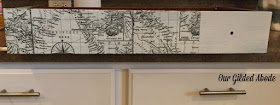A treasured piece of furniture in our home is a chest of drawers that belonged to my dear father-in-law. This sweet chest made a long road trip years ago with hubby and I to our home in Texas from dear father-in-law's home in Ontario, Canada.
We have the perfect place for it in our dining room and it is a convenient and wonderful place to store all of my table linens. It's very dark and layered in decades of aged varnish. After a few years of being in our home, I painted gold stripes on the drawers.
Here's the before:
Recently, I was ready for a change but didn't want to totally refinish it or change the dark exterior.
When I ran across these George Stanley map design paper beverage napkins at Home Goods, I knew they'd be perfect to give the chest a new look!
Supplies used:
~~ Beverage napkins
~~ 2" disposable bristle brush
~~ Plastic wrap
~~ Dark paint (custom mix)
~~ Light paint (custom mix)
The napkins were 3-ply with the top design layer and two solid layers. I separated the design layer from the other 2 layers for each napkin. Only the design layer was used.
Then I painted over the gold stripes with dark paint to match (as closely as I could) the dark color of the chest.
Using Mod Podge thinned with a little water, I brushed the Mod Podge on the drawer front and applied the napkins. This was tricky and on my first attempts, the napkins tore. But, after using a piece of plastic wrap, it worked great. I placed the plastic wrap over the napkin while the glue was still wet, and gently rubbed across the plastic wrap with my fingers and miraculously, the napkins didn't tear!
At this point I was so hopeful this project may actually go as planned! Silly me! (Experienced decoupagers will know exactly where I went wrong.)
As the napkins dried, the light background design of the napkin didn't stay light colored - the dark drawer paint color showed thru and the napkin design was barely visible. Miserable fail on attempt #1!
This is the dried napkin on the dark drawer front - notice all the air bubbles? That's also not the goal. LOL!
I dried my tears and scraped the napkins off the drawer front (fortunately I had only done one drawer), and painted all the drawers a light colored paint.
Back to square one, I repeated the process, gluing the napkins to the drawer fronts. This time, things went much smoother and more quickly.
Left a 1/4" overhang on each side which would be trimmed with an Exacto knife after the napkins dried.
After the drawers dried the design was clearly visible! As I celebrated, I trimmed the excess and then distressed them using 1 teaspoon of Coffee Latte craft paint mixed with 1/8 cup warm water. Just brushed the diluted paint on the drawer fronts and blotted using the plain napkin layers I had separated from the design napkins. No waste!
When the drawers were dried I added oil rubbed bronze drawer pulls that I found in my stash - love when that happens - and she was good to go!
Love the "new" look for this treasured old piece. Have you tried decoupage? Did you run in to any hurdles along the way?
Thank you to Have a Daily Cup of Mrs. Olson, Welcome Home Wednesday, Savvy Southern Style, Create with Joy and My Flagstaff Home for graciously featuring this post!
Shared with:
My Salvaged Treasures * Cozy Little House
My Flagstaff Home *
Imparting Grace * Thoughts from Alice
Dwellings * The Dedicated House
The Scoop - Confessions of a Plate Addict
Must Love Home
Mad In Crafts
A Stroll Thru Life
Chic on a Shoestring
Oh My Heartsie Girl
Savvy Southern Style
Weekend Craft
DIY Just Cuz
Lou Lou Girls
A Delightsome Life
Stone Cottage Adventures
Have a Daily Cup of Mrs. Olson
Knick of Time
My Flagstaff Home *
Imparting Grace * Thoughts from Alice
Dwellings * The Dedicated House
The Scoop - Confessions of a Plate Addict
Must Love Home
Mad In Crafts
A Stroll Thru Life
Chic on a Shoestring
Oh My Heartsie Girl
Savvy Southern Style
Weekend Craft
DIY Just Cuz
Lou Lou Girls
A Delightsome Life
Stone Cottage Adventures
Have a Daily Cup of Mrs. Olson
Knick of Time












































